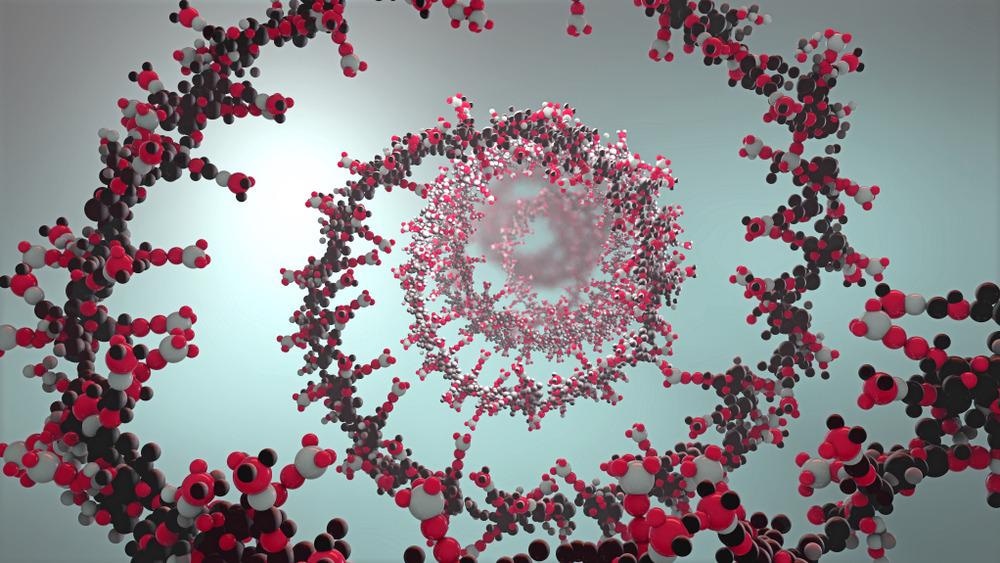Magnetic nanoparticles have both nanoparticles (within a range of 1 to 100 nanometers in diameter) and magnetic particles such as cobalt, iron, and nickel. There is accumulating evidence that magnetic nanoparticles can greatly enhance the detection of nucleic acid.

Image Credit: Christoph Burgstedt/Shutterstock.com
Magnetic nanoparticles
Due to the unique size and physicochemical features of nanoparticle materials, they have several applications in biology or medicine such as gene and drug delivery, fluorescent biological labels, detection of proteins, bio-detection of pathogens, and tissue engineering. It is generally preferred to use particles with superparamagnetic behavior at room temperature in biomedical applications. If the magnetic particles will be used in biology, therapy, and medical diagnosis, they should be stable in water at pH 7 and in physiological environments.
Encapsulation of magnetic nanoparticles with a biocompatible polymer during or after the preparation process is a mandatory process for in vivo biomedical applications. This encapsulation aims to inhibit any change from the original structures, the creation of large aggregates, and biodegradation if displayed to the biological systems. Coating of nanoparticles with polymers facilitates drug binding through entrapment on the particles, covalent attachment, or adsorption.
The main elements, which define the biocompatibility and toxicity of these materials, are the kind of magnetically responsive elements, such as nickel, cobalt, iron, and magnetite, and the final particle size, their core, and the coating. The most commonly used nanoparticles for biomedical applications are iron oxide nanoparticles such as magnetite or its oxidized form maghemite. Nickel and cobalt, which are highly magnetic materials, are toxic and susceptible to oxidation. Therefore, their use is limited.
The use of nanoparticle materials provides many benefits due to their physicochemical properties and their unique sizes. Improved tissue diffusion, higher effective surface areas, and lower sedimentation rates are the major advantages of using particles of sizes smaller than 100 nm. As a result, magnetic nanoparticles, which are used for in vivo biomedical applications, have been made of non-immunogenic, and non-toxic materials, with particle, sizes small enough to stay in the circulation after injection and to go through the capillary system of tissues and organs, staying away from embolism of vessels. These particles must have a high magnetization with the aim that their movements in the blood can be governed by a magnetic field and so that they can be immobilized close to the targeted pathologic tissues.
Recent advances in magnetic nanoparticles in nucleic acid detection
Nucleic acid is one of the most basic substances in life, which has very important biological functions, such as storage and transfer of genetic information. Although the gold standard for the detection of nucleic acid is polymerase chain reaction (PCR), it has some limitations such as the requirement of highly trained personnel, the need for special facilities, and high-cost instrumentation. Thus, it is pivotal to have quick and low-cost nucleic acid equipment and technology.
Magnetic nanoparticles have high binding rates for the detection of substances and a high surface-area-to-volume ratio. They also have good dispersibility, allowing them to bind to biomolecules effectively and quickly. They also can reversibly bind to biomolecules in controllable dispersion and aggregation ways. The particles are homogeneously suspended in solution and nonmagnetic with no need for external magnetic fields. Yet, these are magnetic and could be separated in the presence of an external magnetic field.
High specificity, rapid separation, and good reproducibility are the main advantages of magnetic nanoparticles in nucleic acid detection. Magnetic beads are currently used in nucleic acid extraction. If magnetic characters are coupled with ligands in magnetic beads, this will facilitate the separation and purification of nucleic acid in a specific and highly efficient way.
Chen et al. developed paper-based analytical devices for colorimetric DNA detection, via detection of the specific recognition of nucleic acid through magnetic nanoparticles separation and hybridization chain reaction triggered by target DNA. Wang et al. developed magnetic nanoparticles for the simultaneous extraction of DNA and RNA from cancer cells in a low-cost, convenient, and easy automation way.
Pang et al. designed functionalized Fe3O4@Ag magnetic nanoparticle biosensors for capture and ultra-sensitively detection of microRNA from total RNA in cancer cells. Li et al. developed a quick and high-quality universal nucleic acid extraction kit based on magnetic separation, facilitating the extraction of nucleic acid in an efficient way.
Sources :
- Chen, Weiwei, et al. "DNA-mediated inhibition of peroxidase-like activities on platinum nanoparticles for simple and rapid colorimetric detection of nucleic acids." Biosensors and Bioelectronics 94 (2017): 169-175.
- Li, Bo, et al. "The development of a rapid high-quality universal nucleic acid extraction kit based on magnetic separation." Science China Chemistry 60.12 (2017): 1602-1608
- Pang, Yuanfeng, et al. "Fe3O4@ Ag magnetic nanoparticles for microRNA capture and duplex-specific nuclease signal amplification based SERS detection in cancer cells." Biosensors and Bioelectronics 79 (2016): 574-580.
- Tang, Congli, et al. "Application of magnetic nanoparticles in nucleic acid detection." Journal of nanobiotechnology 18.1 (2020): 1-19.
- Tavallaie, Roya, et al. "Nucleic acid hybridization on an electrically reconfigurable network of gold-coated magnetic nanoparticles enables microRNA detection in blood." Nature nanotechnology 13.11 (2018): 1066-1071.
- Wang, Jiuhai, et al. "Simultaneous extraction of DNA and RNA from hepatocellular carcinoma (Hep G2) based on silica-coated magnetic nanoparticles." Journal of nanoscience and nanotechnology 17.1 (2017): 802-806.
- Wu, Yanqi, et al. "Multifunctional device for nucleic acid extraction based on magnetic separation and its co-working with liquid handling system for high throughput sample preparation." Journal of Nanoscience and Nanotechnology 16.7 (2016): 6919-6924.
Further Reading
Last Updated: Apr 13, 2022